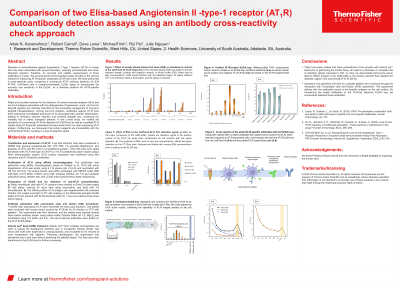Back

(P301) Comparison of two Elisa-based Angiotensin II -type-1 receptor (AT1R) autoantibody detection assays using an antibody cross-reactivity check approach
Location: Platinum Ballroom

Poster Presenter(s)
Aim: Elevation of autoantibodies against AT1R in human sera has been associated with several disorders, including pre-eclampsia and renal-allograph rejection. We performed a cross-reactivity study comparing a commercial AT1R antibody detection kit (Cat. No. EIA AT1RX, CellTrend) and a research-developed ELISA assay. The study was designed to demonstrate accuracy and sensitivity for the ELISA AT1R-Ab detection platform.
Method: AT1R autoantibody detection was performed using either a commercial ELISA kit or the ELISA tray coated with purified human AT1R antigens. Adsorb out™ beads (AOB, One Lambda) were dispensed to a 10:1 ratio (sample: AOB), and the serial dilutions were prepared using dilution buffer in the interference studies. All sera were diluted 1:100 for the ELISA experiments. To prepare BSA dilutions, either PBS or commercial kit dilution buffer was used. Purified human AT1R was confirmed using flow cytometry, Western blot, and mass spectrometry. For the antibody cross-reactivity studies (AXE), we mainly followed the original protocol with some minor modifications.
Results: The AT1R positive signals diminish with increasing AOB in the commercial kit standard samples [Fig. 1]. Besides AOB, incubating the samples with BSA as little as 1µg/mL can block the detection signals, although blocked signals can be fully restored upon removing the BSA from the tray [Fig. 2]. The BSA-related signal suppression was not observed on the internally implemented ELISA tray [Fig. 3]. The results from the AXE1 experiment on each ELISA tray, verify the specificity of the Elisa platform to the AT1R antibody-positive human sera [Fig. 4].
Conclusion: This is a cross-reactivity study between the developed and commercial ELISA assays. The results of this comparison study demonstrate the specificity and accuracy of both developed and commercially available assays.
Method: AT1R autoantibody detection was performed using either a commercial ELISA kit or the ELISA tray coated with purified human AT1R antigens. Adsorb out™ beads (AOB, One Lambda) were dispensed to a 10:1 ratio (sample: AOB), and the serial dilutions were prepared using dilution buffer in the interference studies. All sera were diluted 1:100 for the ELISA experiments. To prepare BSA dilutions, either PBS or commercial kit dilution buffer was used. Purified human AT1R was confirmed using flow cytometry, Western blot, and mass spectrometry. For the antibody cross-reactivity studies (AXE), we mainly followed the original protocol with some minor modifications.
Results: The AT1R positive signals diminish with increasing AOB in the commercial kit standard samples [Fig. 1]. Besides AOB, incubating the samples with BSA as little as 1µg/mL can block the detection signals, although blocked signals can be fully restored upon removing the BSA from the tray [Fig. 2]. The BSA-related signal suppression was not observed on the internally implemented ELISA tray [Fig. 3]. The results from the AXE1 experiment on each ELISA tray, verify the specificity of the Elisa platform to the AT1R antibody-positive human sera [Fig. 4].
Conclusion: This is a cross-reactivity study between the developed and commercial ELISA assays. The results of this comparison study demonstrate the specificity and accuracy of both developed and commercially available assays.

